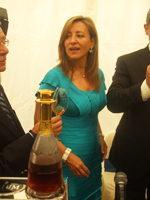 |
| Mayor Sanchez getting ready to taste 100 yr +old Urium Palo Cortado after inauguration |
The show organised for the first time by the Wine Academy, Spain was inaugurated as usual by the beautiful Mayor of Jerez, Ms Pilar Sánchez. She has been the chief guest at least in the previous couple of shows as well. The Magnificent Queen Sherry
The highlight of the opening day had to be the uncorking of a very old and unique Sherry bottle which according to the owner Alonso Ruiz sells for € 20,000 a bottle (taxes extra)-. Gran Señor de Urium, a Palo Cortado presumably over 100 years ago. As his young daughter Rocio Ruiz explains, ‘my father bought the Bodega Urium a few years ago. We inspected it to test the quality of wines and how to categorise them when we discovered a butt which was very old. When we had the wine tasted by experts, they were amazed at the quality and found it at least over a hundred years old and rather unique.’
‘We sell each bottle specially made by a unique Czech glass maker with golden top. The contents are poured into the bottle which is stored in a box made from 4 kgs of silver. We do not sell more than 5 bottles a year due to the very limited supply of this wine,’ she said. It was a unique experience sipping the wine at lunch with Alonso- full of exploding bouquets and spices- all well integrated, doing flamenco on the palate, with the never ending after taste.
Unique Oporto from Australia
An unexpected opening of a bottle of Australian Oporto of 100 years old, a blend of four varieties of grapes in the Australian pavilion, where Pancho Campo MW, Peter Koff MW, Colin Gent MW and a few other journalists tasted and appreciated the black looking gold-this was another highlight at the show.
It was also a great pleasure to taste the verticals of Noble One from De Bortoli- 2006, 2001, 1990 and 1985 when it was labelled as Sauternes. The youngest version of the wine that is used to winning medals at the India Wine Challenge and is imported by Aspri or FineWinesnMore (changes of importers are so frequent now that it is difficult to keep track) should be available in India even now.
MWs Star the Show
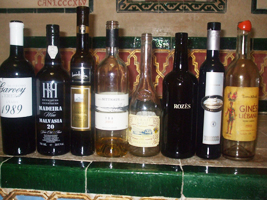 |
| Master Wines tasting with Masters of Wine |
One could not help notice the burgeoning presence of Masters of wines. Sarah Jane Evans must have converted some of the people attending her seminar and tasting on ‘Muscats of the World’ into Muscat lovers. While Pancho Campo talked about the effects of Climate Change on the Noble Wines, Colin Gent from UK presented the Noble Wines from the New World. Peter Koff was involved in more than a couple of seminars while the Swedish MW Ulf Sjödin did a Masterclass on Botrytis.
Master of Wine Grand Tasting
The Grand Tasting at the Mosque- ‘The Master of Wine Grand Tasting’ with 6 MWs outshone the earlier vertical tasting of u d’Yquem conducted by Sandrine Garvay, the Cellar master.
Pancho Campo MW, mustered up a collection of MWs- Ms. Mai Tjemsland (Norway), Sara Jane Evans (UK), Ulf Sjödin (Sweden), Peter Koff (S. Africa) and Collin Gent (UK) were truly the masters who guided the overflowing house to a tasting of equally international wines-some opened for the first time and not even available commercially, with one wine that is celebrating its 100th anniversary this year! (Ginés Pedro Ximénez 1910 Montilla Moriles of Cordoba).
The other wines tasted under the expert guidance of MWs each of whom had an interesting and independent description were (from l to r) Garvey Oloroso Sherry 1989, Henriques Madeira (Malvasia, 20 year +), Inniskillin Vidal Icewine, Nittnhaus Trockenbeerenauslese (TBA) 2002 (Austria), Tokaji Aszu 6 Puttonyos 1993 Disznókö,
Rozés Port 2003 and Moscatel de Alexandria Kracher (99 points RP)
It was quite a memorable tasting-with all different iconic wines. Yquem will have to come up with a more impressive line up for vertical tasting to retain the top spot, though they may always get the top billing.
Chateau d’Yquem Vertical Tasting
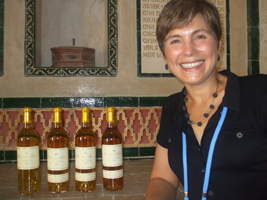 |
| Vertical Tasting of Chateau d'Yquem with Sandrine Garvay |
This has been truly the high point of previous Vinoble shows and one could either be a journalist in the VIP category or use the pull in the office of Mayoress Sánchez (yes, there are a few similarities between Delhi and Jerez!). Pierre Lurton used to conduct the vertical tastings himself. But the responsibilities as CEO of Cheval Blanc and d’Yquem besides other international projects, have made his appearance increasingly difficult. But his key associate, Sandrine, has been conducting the tastings efficiently and professionally. She had selected 2007, 2006, 2000 and 1990 vintages for the vertical tastings. She quickly went through the history of the u, explaining why this is truly the number one in Sauternes and a master in making sweet wines because of the maximum humidity that helps the rot. Located at the highest point, it is driest in the appellation where early fog goes away by 9 am and the dryness helps the grape. Besides, the 100hA has four types of soil. During good years they help give a lot of complexity while in poor years they are able to get a regular, decent wine. Bought over in 1999, there has been no change in the management and it has helped the quality remain at the top. The company believed that 50% of their wine is made in the soil, 40% at the harvest and 10% in the winery. Six pickings from September to November help them achieve the objective.
Barring 1990 which was made in a hot vintage and felt slightly cooked and with not much more scope for improvement, the other three wines were of superb quality. 1996 was still slightly closed. The tasting made the wait and taste quite worthwhile-even for those who did not get a seat in the Mosque and had to be accommodated at the adjoining room El Molino where it was conducted through closed circuit TV.
Seminar on Emerging markets for Sherry
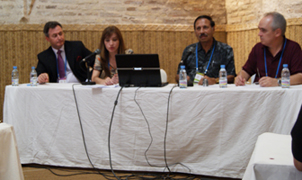 |
| Members of the BRIC Panel |
The second day closing saw a seminar about the emerging markets- BRIC-which has become a fashionable theme. Arthur Azevedo, Eleonora Scholes, Subhash Arora and Stephan Mack represented Brazil, Russia, India and China. Discussing the problems and opportunities for sherry wines in these countries during the closing 30 minutes would be an uphill task even for 100meter running-speakers. But it was interesting to see that the problems created by the importers, hoteliers and the retailers were of similar magnitude in all these countries, the impact of heavy taxes notwithstanding and India is not alone win having no reliable statistics.
No representative from the Consejo Regulador which is also the promoting agency for sherry was apparently present at the seminar making it a fairly futile exercise. To make it more interesting, the organisers needed to allot more time and perhaps could add a small wine tasting of sweet or not-so sweet wines from these countries. India can certainly offer Late Harvest Chenin Blanc for the event, even if the quality dry reds or whites are not acceptable for the tasting.
Vinoble Internacional Concurso
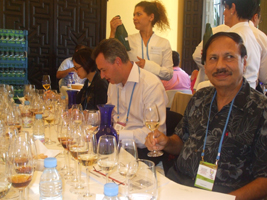 |
| Judging at the Vinoble Internacional Concurso |
For the first time in Vinoble, a wine competition was organised for sherry and sweet wines. Three juries of seven judges tasted Sherries and sweet wines from Spain and other parts of the world. Subhash Arora was invited to preside one of the juries which consisted of Masters of Wine, Ulf Sjödin (Sweden) and Peter Koff (South Africa) and several other international experts like David Fuerer (USA), Jordi Merendo (Spain), Stefan Mack (Hong Kong), Arthur Azevedo Brazil), David and Maria Denton (USA).
Bodega Alvear PX Dulce Viejo 2000 from Montilla-Moriles won the grand gold medal of the Show. The three gold medals, including the above, were awarded to Gonzales Byass Palo Cortado 1978 and Tierras de Mollina Carpe Diem Trasañejo DO Malaga. The competition is expected to pick up momentum in the future edition where it will be a regular feature.
Other Highlights
There were the usual wine presentations from Tokaji, Golden Wines of Bordeaux, Fondillones and Muscatels from Alicante, Montilla-Moriles, Malaga, Vin Doux Naturel, Canary Islands Wines, Austria, Grand Port Tasting, Icewines, Sweet sparkling wines, Madeira, blended Sherries. Several conferences relating to sweet wines were held on all four days. The public tasting at the plaza close to the show grounds, conducted by David and Maria Denton was popular with the general public. It was heartening to later learn from them that ‘the knowledge about sherry wines was rather limited and most people did not even know the types of grapes used.’ Indians are not far behind!
Thanks to the partnership with Real Academia Española de Gastronomia there was more emphasis on the gastronomy this time. But the limited space made participation even more difficult this time.
No Budget Constraints
Denying that there have been any budget cuts, Pancho Campo MW and the President of The Wine Academy, Spain which had been commissioned to organise said that there was no shortage of funds provided by the city. Reacting to people’s complaints about the shortage of space and the rising heat with no respite due to poor air-conditioning, he retorted, ‘we have to realize that this is a heritage venue and things cannot be changed drastically, by law. Besides certain area was lost this time because the archaeologists have found interesting underground structures in parts of the El Alcázar and are now excavating,’ adding that countries like Turkey and Mexico did not participate as they were not willing to pay even the concessional rates offered to them.
Campo who has managed several events through his event management company and has been through some agonizing personal problems was very upbeat about the performance of the show. He claims he helped the city save money by concentrating on buyers and reducing the number of bloggers as invitees. He was very excited about the successful tasting of the complimentary public tastings, an idea jointly conceptualized by the Academy and the Town Hall and organised for the first time.
For a first time effort, the show was quite a success. One did miss the earlier one day event ‘Top Wines of Spain’ that used to be optionally available to the journalists and buyers and was dove-tailed with Vinoble. Surely, Campo will come up with a substitute given the opportunity again. The show is held by the City of Jerez which calls for tenders to organise it on its behalf every two years.
Subhash Arora |